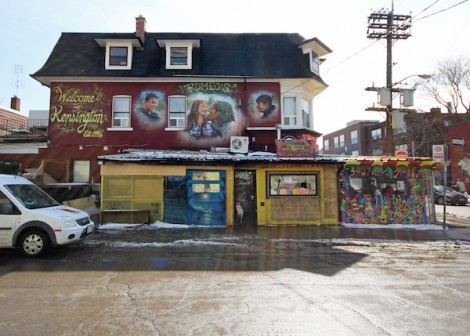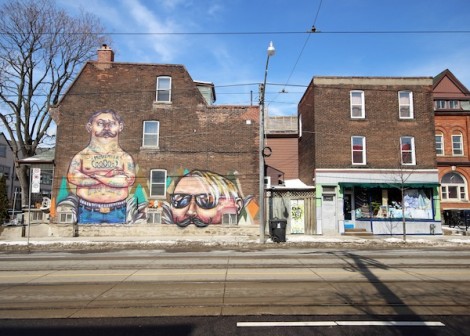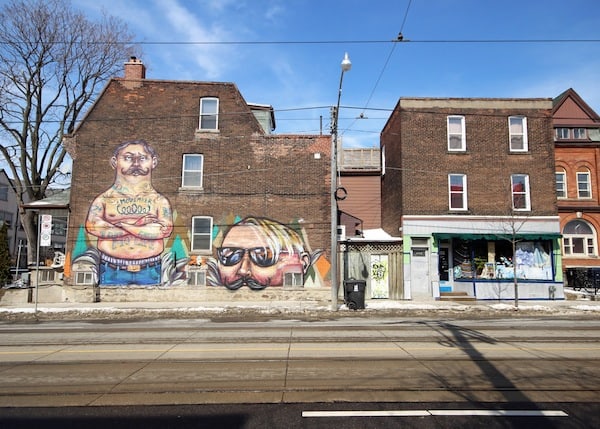Kensington Market

Street art on Augusta Avenue welcomes the eye to Kensington. ADAM ZACHARY/THE VARSITY
Down the road where Bellevue leans in
and curves are houses with driveways
like thick plopped tongues leaking
onto the main street. Walking up
I see three boys holding BB guns
and an empty one abandoned
on the ground next to two stacked cans of pop.
Empty bullet shards drape their feet.
They only quickly look up at me, one boy
shuffling his hand across his hair revealing
little brown eyebrows. I imagine them
flexing up and down, doing a jig. The boys
galloping over driveways, shooting
at brick walls and small animals and girls,
the neighbourhood a bag of shrapnel
with a string tie that sometimes puckers,
sometimes yawns. Instead of hurling down
in clatters, the shrapnel turns to sugar
and the roads absorb it, sweating a little bit.
We swim, cupping our arms in and out
until the streets get too full and crack,
little boy tadpoles pirouetting and dying.
When I get closer the boys run inside the house,
their thin summer shirts are curtains refracting
an evening — a dissipating wilderness of space.
— Melina Mehr
Yonge & St. Clair
I live on Yonge Street, above a bar that attracts revelers who smoke cigarettes on my doorstep late at night. It’s an upscale area pocketed with reminders of an underclass. During the day, suits and heels fill the elegant clothiers and cafés, ignoring the panhandlers stationed outside — but in the evening, I have the streets almost to myself.
This is the best time to ride my bike, looking for a market that sells affordable vegetables. There are no bike lanes on Yonge so I take side streets, winding through imposing houses with impeccable landscaping.
Before dark, I seek refuge from the perpetual noise of the city. I descend for an hour at a time into the stillness of the ravine, trying to find a new path to follow each evening. Most trails are dead ends. I’m always looking for one that leads to some place other than Deer Park, away from the Rosedales and Forest Hills and Avenue Roads of this city. Perhaps one day I will find a path that is not forked.
Trinity Bellwoods

Street art near Trinity-Bellwoods Park reinforces the countercultural atmosphere. AZAM ZACHARY/THE VARSITY
I was to meet her at the corner of Bathurst and Queen. My commute had been quicker than expected, and I had gotten there a good half-hour before our agreed-upon time. There wasn’t a whole lot else to do except wait, unless I could find a way to occupy myself — which, being in an unfamiliar part of town, I was not terribly certain how to do. I was nervous enough as it was,— this was to be our first actual date — so I turned my anxious pacing into leisurely strolling.
The late July sun oozed pleasant warmth onto the pavement, and my shadow and I fumbled our way towards it, walking west along Queen. The notion of exploring a previously untapped neighbourhood was exciting — the actualization of local wanderlust. It was the realization that something could have existed all this time without you knowing it, and the stunned disbelief that it had taken you this long to see it.
I took in as much of the stretch as I could. I found the cupcake place where she and I were to go, and I found Trinity Bellwoods Park, a place of which I had heard but had never seen.
I memorized the neighbourhood by the time I met her at the corner. But as we walked through it, I forgot it entirely. She was all that mattered. We ate cupcakes and read beneath a tree. Trinity-Bellwoods was not geography: it was summer and love and wonder.
— Daniel Konikoff
Christie Pits to Trinity-Bellwoods
Crawford
the street
bends and twirls
confused
switching directions
trying to find its way
she recalls a change
the street remembers how a haven
for summer swimmers
was once a place of industry
and recalls a night of violence
the street holds up
a man from Pakistan
on the steps of his Portuguese store
he smiles at three children
running past
creating a cloud of dust
that hovers above the sidewalk
onto the street
the man flicks the ash of his cigarette
and gives a friendly nod to the professor-parents
who wearily follow
their overzealous spawn
to the promised after-dinner gelato
glancing across the street
an old woman hears the commotion
she is reminded of the days when
it was her house full of noise
she laments,
her sons have all left for
backyard pools in suburban lands
that seem a world away
the street watches
young men brawl at midnight
fueled by cheap martinis and churros
interrupted by an insomniac
pushing past their brawn
into a store that never closes
the street rolls down the hill
reminiscing about a creek
that once past through her
she widens
where men in robes once walked
scarved lovers dodge unleashed dogs
the street pauses
wary of the streetcars whizzing past her
— India McAlister
Bloor West Village
Bloor West Village clings to its traditional soul — Pizza Pizza and McDonald’s are juxtaposed against quaint flower shops and hand-crafted jewellery stores. I can see the lifelines disappearing, one by one. Laura Secord first, where I used to go for $1 chocolate, and Hallmark, where I would laugh at the musical cards. Then Book City followed; Baskin Robbins next, where 30 cent scoop day would be the highlight of April in middle school; then the smaller cafés and Write Impressions last summer. There are ten coffee shops here now: Starbucks, Timothy’s, Coffee Tree, and seven more. Seven beauty salons, five elementary schools, and a movie theatre. We have managed to avoid condos until now, but we lost the historic-theatre-turned-bookstore to another Shoppers Drug Mart this month.
The quiet, serene side-streets and grassy parks lace into bustling Bloor like veins feeding a beating heart. It’s a different world just one minute down the road, where stray cats hiss at raccoons and kids toboggan down Rennie hill after an hour at the skating rink. It is a simpler world of swing-sets, brightly coloured playgrounds, and lakeside trails down to High Park and lakeshore. In the middle of it all, tradition and and change are wrestling for the upper hand. We have the best of both worlds, but it’s unlikely to stay that way.
— Linh Nguyen


